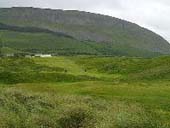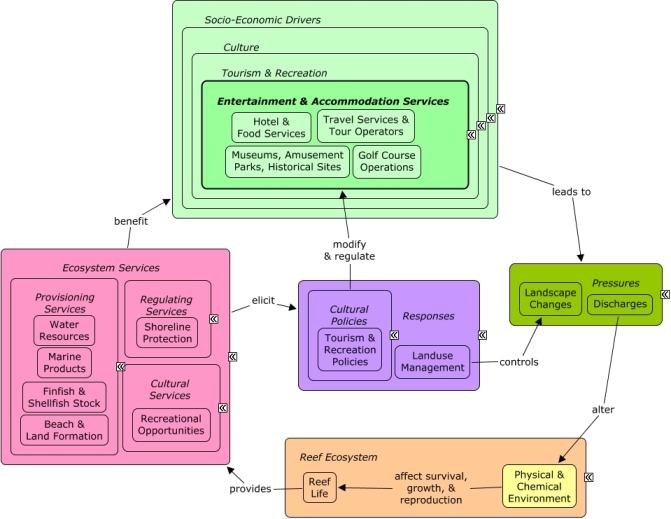ReefLink Database

Golf Course Operations
The Golf Course Operations subsector of the Entertainment and Accommodation Services sector consists of establishments that operate golf courses, including country clubs that also offer dining and other recreational facilities.
CMap

CMap Description
Tourism & recreation requires construction of hotels, restaurants, docks, marinas, beaches and natural areas, which contribute to landscape changes and alter pollutant runoff into coastal systems. Tourism activities involving contact uses (boating, swimming, fishing) may cause physical damage to reef species,. Tourism & recreation sectors directly benefit from many ecosystem services, including the aesthetic value of the reef and clean, calm waters, which provide recreational opportunities and contribute to the cultural identity of the local community. The reef ecosystem also provides seafood and marine products, such as ornamental jewelry and other souvenirs. Decision-makers can enact policies to increase tourism, guide the activities of tourists, or alter the location or number of service providers through city planning, zoning, and permitting.Citations
| Citation | Year | Study Location | Study Type | Database Topics |
|---|---|---|---|---|
| Knee, K. L., J. H. Street, E. E. Grossman, A. B. Boehm, and A. Paytan. 2010. Nutrient inputs to the coastal ocean from submarine groundwater discharge in a groundwater-dominated system: Relation to land use (Kona coast, Hawaii, USA). Limnology and Oceanography 55:1105-1122. | 2010 | US Pacific & Hawaii | Agriculture; Discharges; Golf Course Operations; Nutrients; Salinity; Surface & Groundwater Flow | |
| Kawauchi, G. Y. and M. E. Rice. 2009. Two new species of Nephasoma (Sipuncula: Golfingiidae) from the Western Atlantic Ocean. Proceedings of the Biological Society of Washington 122:13-Jan. | 2009 | Florida; US East Coast (NC, SC, GA); Atlantic Ocean | Review | Golf Course Operations; Marine Worms; Skeletal Coral |
| Pyke, G. H., J. Rowley, J. Shoulder, and A. W. White. 2008. Attempted introduction of the endangered Green and Golden Bell Frog to Long Reef Golf Course: A step towards recovery. Australian Zoologist 34:361-372. | 2008 | Golf Course Operations; Pathogens | ||
| Fowler, J., T. C. Stephens, M. Santiago, and P. de Bruin. 2002. Amwaj Islands constructed with geotubes, Bahrain. World Dredging, Mining and Construction 38:Jun-40. | 2002 | Bahrain | Field Study & Monitoring; Lab Study | Dredging, Draining, & Filling; Golf Course Operations; Hotel & Food Services; Housing; Shoreline Protection; Storms & Hurricanes |
| Maragos, J. E. 2000. Hawaiian Islands (U.S.A.). Seas at the millennium - an environmental evaluation - Volume 2 791-812. | 2000 | US Pacific & Hawaii | Field Study & Monitoring | Agriculture; Anchoring & Vessel Grounding; Apex Fish Predators; Aquaculture; Aquarium & Pet Trade; Aquarium Stock; Beaches & Nature Parks; Boating Activities; Boating Regulations; Dredging Regulations; Dredging, Draining, & Filling; Environmental Education & Outreach; Environmental Monitoring, Mapping, & Scientific Research; Finfish Harvest; Fish; Fishing Sector; Golf Course Operations; Hotel & Food Services; Invasive Species; Marine Birds; Marine Debris; Marine Protected Areas; Military; Pathogens; Recreational Fishing; Scientific Research; Sea Turtles; Sediment; Special Use Permitting; Storms & Hurricanes; Tourism & Recreation; Trawling & Fishing Gear Damage; Waterborne Discharges; Wetlands |
| Chandrasena, N. and R. Sim. 1999. Managing entrenched weed problems in botany wetlands - An urban stormwater basin in Sydney. Pages 313-319 in Water Supply. | 1999 | Chemical Use Regulations; Dredging, Draining, & Filling; Fertilizer & Pesticide Use; Golf Course Operations; Non-point Source Runoff; Nutrients; Sediment; Solid Waste Disposal; Surface & Groundwater Flow; Valuation; Water; Wetlands | ||
| White, K. and A. Meyers. 1997. Stormwater Management and Aesthetics Using Stormwater Treatment Wetlands, Aesthetics in the Constructed Environment, Houston, TX. in Proceedings of the 4th Annual ASCE Water Resources Planning and Management Conference. | 1997 | Golf Course Operations; Non-point Source Runoff; Surface & Groundwater Flow; Wetlands | ||
| Chen, K. M. 1995. Disappearance of ALS from Guam: Implications for exogenous causes. Pages 1549-1553 in Clinical Neurology. | 1995 | US Pacific & Hawaii; Cuba; Guam | Deforestation & Devegetation; Drinking Water Supply; Golf Course Operations; Hotel & Food Services; Housing; Military; Pathogens; Surface & Groundwater Flow; Tourism & Recreation; Water | |
| Richmond, R. H. 1994. Effects of coastal runoff on coral reproduction. Pages 360-364 in Proceedings of the colloquium on global aspects of coral reefs, Miami, 1993. | 1994 | Global; US Pacific & Hawaii; Guam | Golf Course Operations; Hotel & Food Services; Housing; Non-point Source Runoff; Salinity; Sediment | |
| Lum, D. 1983. Limestone Resources Of Hawaii. Transactions of the American Institute of Mining, Metallurgical, and Petroleum Engineers, Society 274:1991-1996. | 1983 | US Pacific & Hawaii | Agriculture; Dredging, Draining, & Filling; Golf Course Operations; Manufacturing & Trade; Ports & Harbors; Water Depth & Sea Level |
Management Options
| Management Option | Description | Sources | Database Topics |
|---|---|---|---|
| Corporate Response: Develop Outreach with Local Businesses | Information should be provided to business along the water so that employees will be aware of environmentally sensitive business practices. This can be achieved through informative brochures, and distributing other educational materials. These interactions can also be used to inform businesses of opportunities for voluntary certifications (#104). | NOAA Marine Sanctuary Program. 2007. Florida Keys National Marine Sanctuary revised management plan. National Ocean Service, Key West, FL. The Coral Reef Alliance (CORAL) the Tour Opperators' Iniative (TOI) and The Center for Environmental Leadership in Business (CELB). 2003. A Practical Guide to Good Practice: Managing Environmental Impacts In The Marine Recreation Sector. |
Coastal Development; Collaboration & Partnering; Corporate Responses; Cultural Policies; Entertainment & Accommodation Services; Environmental Education & Outreach; Golf Course Operations; Hotel & Food Services; Infrastructural Policies; Manufacturing & Trade; Wholesale & Retail Trade |
| Stormwater BMPs: Biological Stormwater Filtration | This method attempts to reduce the negative impacts of stormwater runoff through implementing engineering techniques that allow natural processes and plants to act as filters. Such techniques would include using grass parking and turf covered swales. Many of these techniques, such as reversed elevations for planted areas in parking lots, can demonstrate benefits both as natural filters and for the vegetation that are used since it eliminates the need to water them with irrigation systems. | NOAA Marine Sanctuary Program. 2007. Florida Keys National Marine Sanctuary revised management plan. National Ocean Service, Key West, FL. Natural Resources Conservation Service. 2011. National Handbook of Conservation Practices. U.S. Department of Agriculture. Natural Resources Conservation Service. Basic Biofiltration Swale. Urban BMP's - Water Runoff Management Accessed 3/23/2011. Natural Resources Conservation Service. Bioretention System. Urban BMP's - Water Runoff Management Accessed 3/23/2011. Natural Resources Conservation Service. Constructed Wetland. Urban BMP's - Water Runoff Management Accessed 3/23/2011. Natural Resources Conservation Service. Filter Strips. Urban BMP's - Water Runoff Management Accessed 3/23/2011. Natural Resources Conservation Service. Reversed Elevations System for Parking Lots and Planting Areas. Urban BMP's - Water Runoff Management Accessed 3/23/2011. Natural Resources Conservation Service. Riparian Forest Buffer. Urban BMP's - Water Runoff Management Accessed 3/23/2011. Natural Resources Conservation Service. Roadway Landscape Treatment System. Urban BMP's - Water Runoff Management Accessed 3/23/2011. Natural Resources Conservation Service. Wet Biofiltration Swale. Urban BMP's - Water Runoff Management Accessed 3/23/2011. Natural Resources Conservation Service. Wet Pond Design. Urban BMP's - Water Runoff Management Accessed 3/23/2011. Natural Resources Conservation Service. Wet Swale. Urban BMP's - Water Runoff Management Accessed 3/23/2011. Water Environment Research Foundation, American Society of Civil Engineers, U.S. Environmental Protection Agency, Federal Highway Administration, American Public Works Association, editor. 2008. Overview of Performance by BMP Category and Common Pollutant Type. International Stormwater Best Management Practices (BMP) Database [1999-2008]. Leisenring, M., Clary, J., Stephenson, J., and Hobson, P. 2010. International Stormwater Best Management Practices (BMP) Database Pollutant Category Summary: Nutrients. Geosyntec Consultants, Inc. |
Applied Chemicals; Building & Home Construction; Chemical Variables; City Planning; Civil Engineering & Construction; Climate; Construction Codes & Projects; Deforestation & Devegetation; Discharge Limitations; Discharges; Ditching & Soil Disturbance; Fertilizer & Pesticide Use; Golf Course Operations; Impervious Surfaces; Infrastructure; Irrigation; Land-Based Civil Engineering; Landscape Changes; Landscape Conservation & Restoration; Landscaping & Household Services; Landuse Management; Non-point Source Controls; Non-point Source Runoff; Nutrient & Contaminant Processing; Physical Variables; Point & Mobile Source Controls; Point Source Discharges; Primary Production; Road Construction & Maintenance; Sediment; Storms & Hurricanes; Stormwater Management; Substrate; Supporting Services; Surface & Groundwater Flow; Toxics; Utilities; Waste Management; Waste Management Policies; Wastewater Discharge; Water; Waterborne Discharges |
Laws
| Legal Citation | Purpose of Law | Management Organization | Database Topics |
|---|
